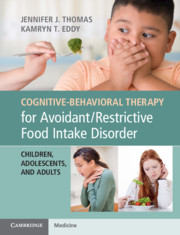 Cognitive-Behavioral Therapy for Avoidant/Restrictive Food Intake Disorder
Cognitive-Behavioral Therapy for Avoidant/Restrictive Food Intake Disorder Book contents
- Cognitive-Behavioral Therapy for Avoidant/Restrictive Food Intake Disorder
- Reviews
- Cognitive-Behavioral Therapy for Avoidant/Restrictive Food Intake Disorder
- Copyright page
- Dedication
- Contents
- Foreword
- Preface
- Acknowledgments
- Chapter 1 What Is ARFID?
- Chapter 2 Overview of Existing Treatments for Feeding, Eating, and Anxiety Disorders
- Chapter 3 Assessment of ARFID
- Chapter 4 Cognitive-Behavioral Model of ARFID
- Chapter 5 Overview of CBT-AR
- Chapter 6 Stage 1: Psychoeducation and Early Change
- Chapter 7 Stage 2: Treatment Planning
- Chapter 8 Stage 3: Maintaining Mechanisms in Order of Priority
- Chapter 9 Stage 4: Relapse Prevention
- Chapter 10 CBT-AR Case Examples
- Chapter 11 Conclusion and Future Directions
- Book part
- References
- Index
- References
References
Published online by Cambridge University Press: 26 October 2018
- Cognitive-Behavioral Therapy for Avoidant/Restrictive Food Intake Disorder
- Reviews
- Cognitive-Behavioral Therapy for Avoidant/Restrictive Food Intake Disorder
- Copyright page
- Dedication
- Contents
- Foreword
- Preface
- Acknowledgments
- Chapter 1 What Is ARFID?
- Chapter 2 Overview of Existing Treatments for Feeding, Eating, and Anxiety Disorders
- Chapter 3 Assessment of ARFID
- Chapter 4 Cognitive-Behavioral Model of ARFID
- Chapter 5 Overview of CBT-AR
- Chapter 6 Stage 1: Psychoeducation and Early Change
- Chapter 7 Stage 2: Treatment Planning
- Chapter 8 Stage 3: Maintaining Mechanisms in Order of Priority
- Chapter 9 Stage 4: Relapse Prevention
- Chapter 10 CBT-AR Case Examples
- Chapter 11 Conclusion and Future Directions
- Book part
- References
- Index
- References
- Type
- Chapter
- Information
- Cognitive-Behavioral Therapy for Avoidant/Restrictive Food Intake DisorderChildren, Adolescents, and Adults, pp. 170 - 175Publisher: Cambridge University PressPrint publication year: 2018


